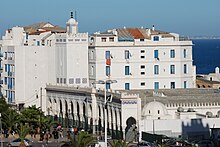Great Mosque of Algiers
| Great Mosque of Algiers | |
|---|---|
| الجامع الكبير (Arabic) Grande Mosquée (French) |
|

Great Mosque of Algiers
Djama’a al-Kebir |
|
| Basic information | |
| Location | Algiers, Algeria |
| Affiliation | Sunni Islam |
| Year consecrated | 1097 |
| Architectural description | |
| Architectural type | Mosque |
| Architectural style | Islamic, Almoravid |
| Completed | 1097, 1324 and 1840 |
| Minaret(s) | 1 |
The Great Mosque of Algiers (Arabic: الجامع الكبير, Jemaa Kebir) or “Djama’a al-Kebir” (meaning Great Mosque) is a mosque in Algiers, Algeria, located very close to Algiers Harbor. An inscription on the minbar (منبر) or the pulpit testifies to fact that the mosque was built in 1097. It is also known by several other names such as Grand Mosque d'Alger, Djamaa al-Kebir, El Kebir Mosque and Jami Masjid. It is one of the few remaining examples of Almoravid architecture. It is the oldest mosque in Algiers and is said to be the oldest mosque in Algeria after Sidi Okba Mosque. It was built under sultan Ali ibn Yusuf. Its minaret dates from 1332 (1324 in some sources) and was built by the Ziyyanid Sultan of Tlemcen. The gallery at the outside of the mosque was built in 1840. Its construction was a consequence of a complete reconstruction of the street by the French.
The Great Mosque is located in the northeastern part of the city in the historic Kasbah area near the harbor, next to the Chamber of Commerce. Earlier, the mosque was located on the Rue de la Marine in Algiers during French colonial rule of Algeria, which was then the entrance street to Algiers Harbor. Rue de la Marine no longer exists and has been surpassed by the Rue d' Angkor and Boulevard de Ernesto Guevara and in the mosque area by a fork road called Rue Saadi et Mokhtar Ben Hafidh which it now lies on. The mosque is seen here with reordered portico of columns and poly-lobed arches that were built at the beginning of the colonial period. These precede the façade of the mosque, consequent to realignment of streets in the area.
The mosque has a rectangular courtyard of 38×46 meters on a 9×11 grid. The narrow sides of the rectangle (with width larger than the perpendicular depth) have a riwaq (gallery). This layout has been replicated in many religious structures, e.g., the al-Aqsa Maghreb mosque in Algeria. While the main mosque was built in 1097 AD (Hegira 490), according to the minbar, the minaret on the north-western corner was a later addition (according to an inscription at its base), in 1332, by sultan Ali ibn Yusuf. The gallery surrounding the main mosque was added in 1840.
...
Wikipedia
